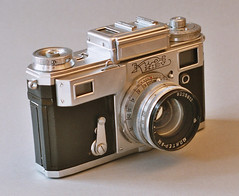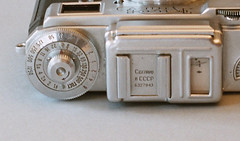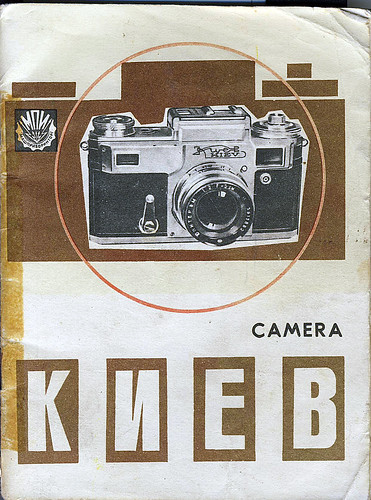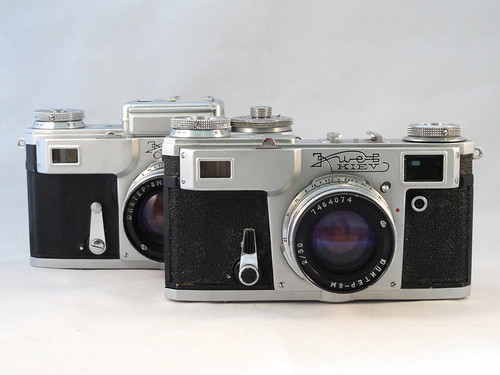Difference between revisions of "Kiev 4"
(→Links) |
Hanskerensky (talk | contribs) (→Links: Refined Link URL) |
||
| (34 intermediate revisions by 12 users not shown) | |||
| Line 1: | Line 1: | ||
| − | + | {| class="toccolours plainlinks" align= "right" style="clear: both; text-align: left; margin: 0 0 1em 1em;" | |
| − | |||
| − | |||
| − | |||
| − | |||
| − | |||
| − | |||
| − | |||
| − | |||
| − | |||
| − | |||
| − | |||
| − | |||
| − | |||
| − | |||
| − | |||
| − | |||
| − | |||
| − | |||
| − | |||
| − | |||
| − | |||
| − | |||
| − | |||
| − | |||
| − | |||
| − | |||
| − | |||
| − | |||
| − | |||
| − | |||
| − | |||
| − | |||
| − | |||
| − | |||
| − | |||
| − | |||
| − | |||
| − | {| class="toccolours" align= "right" style="clear: both; text-align: left; margin: 0 0 1em 1em;" | ||
|- | |- | ||
| − | ! bgcolor="#A5C9EB" | Kiev 4 | + | ! bgcolor="#A5C9EB" | [[Kiev rangefinder|Kiev]] 4 |
|- | |- | ||
| style="font-size: 95%;" | | | style="font-size: 95%;" | | ||
| + | <div align="center"> | ||
| + | {{Flickr_image | ||
| + | |image_source= http://www.flickr.com/photos/50678983@N00/163598902/in/pool-camerawiki | ||
| + | |image= http://static.flickr.com/70/163598902_5f1700b7cc_m.jpg | ||
| + | |image_align= left | ||
| + | |image_text= Kiev 4 type 1 rangefinder | ||
| + | |image_by= Dries van den Elzen | ||
| + | |image_rights= with permission | ||
| + | }} | ||
| + | </div> | ||
| + | {{br}} | ||
'''Maker:''' Arsenal, Kiev | '''Maker:''' Arsenal, Kiev | ||
'''Dates:''' 1950s | '''Dates:''' 1950s | ||
| − | '''Variants:''' | + | '''Variants:''' Kiev 4A, 4AM, 4M |
'''Camera Type:''' 35mm rangefinder system | '''Camera Type:''' 35mm rangefinder system | ||
| Line 77: | Line 50: | ||
'''Battery:''' None | '''Battery:''' None | ||
| − | ---- | + | |} |
| + | __TOC__ | ||
| + | The [[Kiev rangefinder|Kiev rangefinder cameras]] were developed after WW II in the [[Arsenal]] factory in Kiev (Ukraine). Soviet forces had "relocated" equipment and personnel from the Zeiss Ikon factories in Germany. In Kiev [[Zeiss Ikon]]'s [[Contax rangefinder|Contax]] production line was set up again and quickly started production under the Kiev brand name. Early models are said to have been made from original Zeiss Ikon stock the Soviets had taken with them. There are reports of models with the original Contax nameplate behind the new Kiev shield. | ||
| + | |||
| + | One of the excellent things about this Kiev is its long [[rangefinder base]]: 9 cm. This allows for very accurate focusing. For example, when you are focusing for a tightly composed portrait, you see a clear difference when the nose or the eyes are in perfect focus. Combined with the clear depth-of-field scale on the lens, this allows isolation of the subject from the background. Furthermore, the viewfinder and rangefinder are combined in one large bright window so you do not have to look through two windows for focusing and framing. [[Leica]] did not combine the two until the [[Leica M3]] in 1954. | ||
| + | |||
| + | Kiev 4 and 4A (non-metered) are a follow up to the Kiev II and III which were copies of the Contax II and III respectively. With several improvements over the original design. | ||
| + | It was made between 1956 and 1987 in several variations of the model, and over 1 million cameras were sold worldwide.. | ||
| + | |||
| + | {{Flickr_image | ||
| + | |image_source= https://www.flickr.com/photos/heritagefutures/16460980491/ | ||
| + | |image= http://farm8.staticflickr.com/7409/16460980491_772c95be9a_m.jpg | ||
| + | |image_align= left | ||
| + | |image_text= Russar MR-2 (PУCCAP MP-2) 20mm f/5.6 on Kiev 4 | ||
| + | |image_by= Dirk HR Spennemann | ||
| + | |image_rights= wp | ||
| + | }}{{brl}} | ||
| + | == Contax Bayonet mount == | ||
| + | <div class="plainlinks floatleft"> | ||
| + | [http://www.flickr.com/photos/50678983@N00/163599761/in/pool-camerawiki/ http://static.flickr.com/76/163599761_68d01cf027_n.jpg]<br/> | ||
| + | {{Flickr_image_caption | ||
| + | |image_text= | ||
| + | |image_by= Dries van den Elzen | ||
| + | |image_rights= wp | ||
| + | }} | ||
| + | </div> | ||
| + | In many ways the Kiev is a reliable Contax clone and a sturdy piece of metal equipment. The bayonet for the lenses is the [[Contax rangefinder mount]], so [[Carl Zeiss]] made Contax lenses can be used. This particular lens is a [[Jupiter-8M]] standard 50/2 lens. | ||
| + | |||
| + | It was made at the Arsenal plant and its serial number, starting "62", suggests it was produced in 1962. The lens has an engraved distance scale and ''two'' diaphragm scales, one visible from the top and the other only seen from the bottom of the lens. This is because the lens rotates during focusing, and the design allows one scale or other to be at least partially visible from above. In some focusing positions, the two scales are to the left and to the right. (By contrast, the [[Sonnar]] for the [[Contax II]] has only one scale, and the camera must be turned upside down to set the aperture at some focusing positions.) | ||
| + | {{br}} | ||
| + | |||
| + | == Exposure meter == | ||
| + | <div class="floatleft plainlinks">[http://www.flickr.com/photos/50678983@N00/164736970/in/pool-camerawiki/ http://static.flickr.com/46/164736970_8cd29252c8_m.jpg]<br/> | ||
| + | {{Flickr_image_caption | ||
| + | |image_text= | ||
| + | |image_by= Dries van den Elzen | ||
| + | |image_rights= wp | ||
| + | }}</div> | ||
| + | The [[light meter]] on top of the camera is of the [[selenium]] cell type. By turning the ring on the left, the needle in the window is matched to the diamond. For overexposure by one or two stops, the meter has the marks -2 and -4 to extend its usability. A speed and aperture combination can then be read from the two metal rings. Of course this meter is not coupled to the lens; the photographer has to set these parameters by hand. Most selenium cell meters are dead or inaccurate now since they do not age very well. The sensitivity range on this camera is set in [[GOST]], the Soviet equivalent of ISO/ASA. Note that the coldshoe proudly states : "sdelano b SSSR"; made in the USSR. This may mean they were considered to be of export quality. The serial number ''63''27943 indicates this particular camera was made in 1963. | ||
| + | {{br}} | ||
| + | ==Gallery== | ||
| + | {|class=plainlinks | ||
| + | ||[http://www.flickr.com/photos/50678983@N00/163598899/in/pool-camerawiki/ http://static.flickr.com/69/163598899_9b7fb857bf_n.jpg] | ||
| + | ||[http://www.flickr.com/photos/50678983@N00/163598898/in/pool-camerawiki/ http://static.flickr.com/65/163598898_0e81f06328_n.jpg] | ||
| + | ||[http://www.flickr.com/photos/50678983@N00/163598897/in/pool-camerawiki/ http://static.flickr.com/55/163598897_55ad5319b5_n.jpg] | ||
| + | |- | ||
| + | | colspan=3 align=center | | ||
| + | Kiev 4<br /><small>images by {{image author|Dries van den Elzen}}</small> {{with permission}} | ||
| + | |||
| + | {{Flickr_image | ||
| + | |image_source= https://www.flickr.com/photos/thorpehamlet/8569383040/in/pool-camerawiki/ | ||
| + | |image= http://farm9.staticflickr.com/8388/8569383040_6e27b8c4c7.jpg | ||
| + | |image_align=left | ||
| + | |image_text= manual of Kiev 4 and Kiev 4A | ||
| + | |image_by= John-Henry Collinson | ||
| + | |image_rights= wp | ||
| + | }} | ||
| + | {{Flickr_image | ||
| + | |image_source= https://www.flickr.com/photos/30811353@N04/8532355143/in/pool-camerawiki/ | ||
| + | |image= http://farm9.staticflickr.com/8524/8532355143_efd04dc2ea.jpg | ||
| + | |image_align=left | ||
| + | |image_text= Kiev 4 behind the meterless Kiev 4A | ||
| + | |image_by= Justin Jakobson | ||
| + | |image_rights= nc | ||
| + | }} | ||
| + | |} | ||
| + | ==Links== | ||
| + | *[http://www.sovietcams.com/indexf863.html?tmpl_into=middle&tmpl_id=272&_m_e_id=24&_menu_i_id=198 Kiev 4] and [http://www.sovietcams.com/indexcabb.html?tmpl_into=middle&tmpl_id=273&_m_e_id=24&_menu_i_id=199 Kiev 4A] pages at [http://www.sovietcams.com/index.html Sovietcams.com] | ||
| + | <!--Commented out link, page no longer present/available, please remove if not returned by 6/2023 * [http://www.fotoua.com/1cameraAlltip.php?st=7&rd=4&usl=&usl1=&seek1=112&seek2=135 Kiev 4 typology of variants] (Fotua site) --> | ||
| + | * [https://web.archive.org/web/20150324071109/http://ken.lyndrup.dk/Engelsk/KIEV%20E/Kiev-4.htm Kiev 4] (archived) by Ken Lyndrup, Denmark | ||
| + | * [https://www.butkus.org/chinon/russian/kiev-4/kieva-a-splash.htm Kiev 4 and 4A instruction manual] at [https://www.butkus.org/chinon/ Butkus.org] | ||
| + | * JM Burtscher sovietcamera website : [https://web.archive.org/web/20160110184613/http://sovietcamera.fr/ Sovietcamera french website] (archived) | ||
| + | * [http://www.collection-appareils.fr/x/html/page_standard.php?id_appareil=45 Kiev 4] on [http://www.collection-appareils.fr/general/html/francais.php www.collection-appareils.fr] by Sylvain Halgand (in French) | ||
| + | * [http://cschu.redirectme.net/mirrored/cameraquest/www.cameraquest.com/zconrfKiev.htm Kiev Rangefinders] by Peter Henning | ||
| + | [[Category:Soviet cameras]] | ||
[[Category: Contax rangefinder mount]] | [[Category: Contax rangefinder mount]] | ||
[[Category: K]] | [[Category: K]] | ||
[[Category: Arsenal]] | [[Category: Arsenal]] | ||
Latest revision as of 05:43, 29 June 2022
| Kiev 4 | ||
|---|---|---|
Dates: 1950s Variants: Kiev 4A, 4AM, 4M Camera Type: 35mm rangefinder system Focusing: manual Rangefinder: rangefinder with a 9 cm base Lens mount: Contax mount Shutter: vertical blade shutter Exposure meter: selenium cell ASA/ISO range: 8-500 GOST (i. e. 8–500 ASA) Shoe: coldshoe Synchronized: X sync speed: TTL Flash: None Motor drive: None Battery: None |
The Kiev rangefinder cameras were developed after WW II in the Arsenal factory in Kiev (Ukraine). Soviet forces had "relocated" equipment and personnel from the Zeiss Ikon factories in Germany. In Kiev Zeiss Ikon's Contax production line was set up again and quickly started production under the Kiev brand name. Early models are said to have been made from original Zeiss Ikon stock the Soviets had taken with them. There are reports of models with the original Contax nameplate behind the new Kiev shield.
One of the excellent things about this Kiev is its long rangefinder base: 9 cm. This allows for very accurate focusing. For example, when you are focusing for a tightly composed portrait, you see a clear difference when the nose or the eyes are in perfect focus. Combined with the clear depth-of-field scale on the lens, this allows isolation of the subject from the background. Furthermore, the viewfinder and rangefinder are combined in one large bright window so you do not have to look through two windows for focusing and framing. Leica did not combine the two until the Leica M3 in 1954.
Kiev 4 and 4A (non-metered) are a follow up to the Kiev II and III which were copies of the Contax II and III respectively. With several improvements over the original design. It was made between 1956 and 1987 in several variations of the model, and over 1 million cameras were sold worldwide..
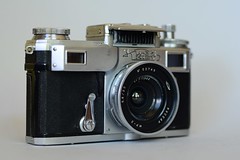
|
| Russar MR-2 (PУCCAP MP-2) 20mm f/5.6 on Kiev 4 image by Dirk HR Spennemann (Image rights) |
Contax Bayonet mount
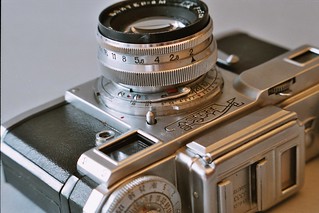
images by Dries van den Elzen (Image rights)
In many ways the Kiev is a reliable Contax clone and a sturdy piece of metal equipment. The bayonet for the lenses is the Contax rangefinder mount, so Carl Zeiss made Contax lenses can be used. This particular lens is a Jupiter-8M standard 50/2 lens.
It was made at the Arsenal plant and its serial number, starting "62", suggests it was produced in 1962. The lens has an engraved distance scale and two diaphragm scales, one visible from the top and the other only seen from the bottom of the lens. This is because the lens rotates during focusing, and the design allows one scale or other to be at least partially visible from above. In some focusing positions, the two scales are to the left and to the right. (By contrast, the Sonnar for the Contax II has only one scale, and the camera must be turned upside down to set the aperture at some focusing positions.)
Exposure meter
The light meter on top of the camera is of the selenium cell type. By turning the ring on the left, the needle in the window is matched to the diamond. For overexposure by one or two stops, the meter has the marks -2 and -4 to extend its usability. A speed and aperture combination can then be read from the two metal rings. Of course this meter is not coupled to the lens; the photographer has to set these parameters by hand. Most selenium cell meters are dead or inaccurate now since they do not age very well. The sensitivity range on this camera is set in GOST, the Soviet equivalent of ISO/ASA. Note that the coldshoe proudly states : "sdelano b SSSR"; made in the USSR. This may mean they were considered to be of export quality. The serial number 6327943 indicates this particular camera was made in 1963.
Gallery
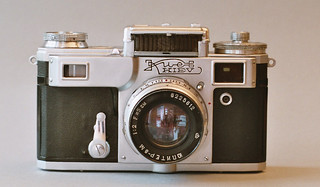
|
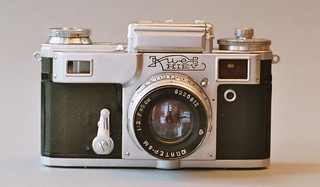
|
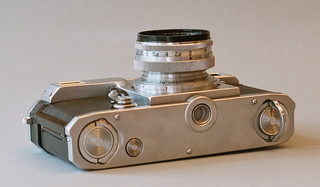
| ||||
|
Kiev 4
| ||||||
Links
- Kiev 4 and Kiev 4A pages at Sovietcams.com
- Kiev 4 (archived) by Ken Lyndrup, Denmark
- Kiev 4 and 4A instruction manual at Butkus.org
- JM Burtscher sovietcamera website : Sovietcamera french website (archived)
- Kiev 4 on www.collection-appareils.fr by Sylvain Halgand (in French)
- Kiev Rangefinders by Peter Henning
